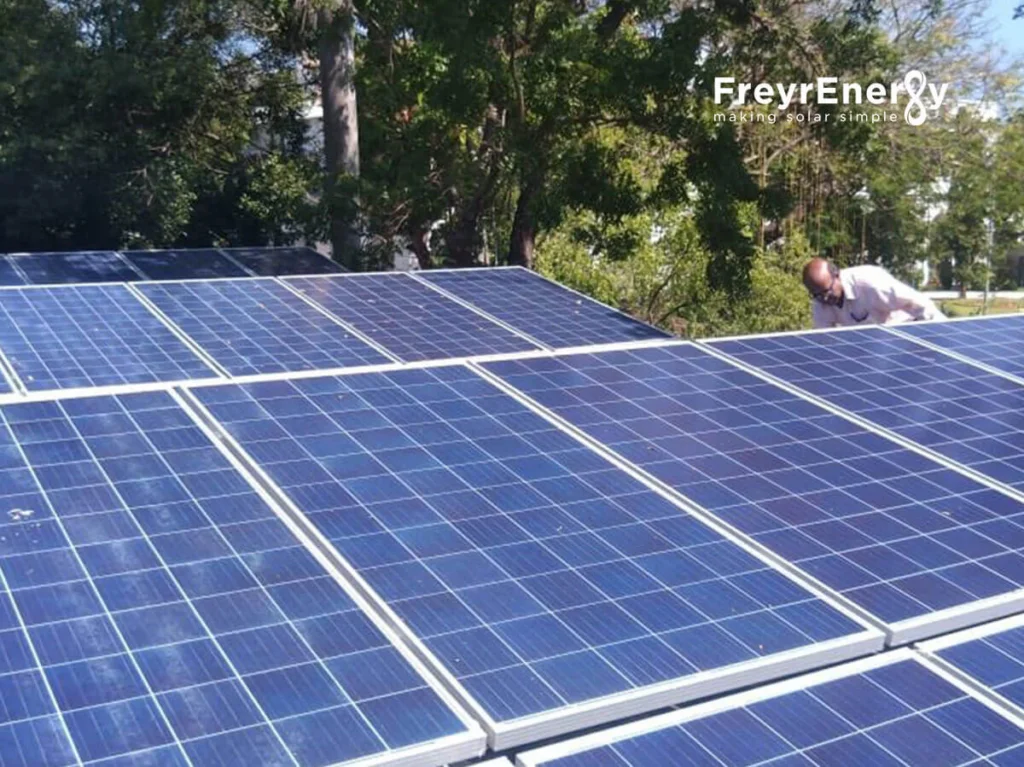Solar rooftop photovoltaic system, more commonly known as a rooftop PV system, captures the light energy emitted by the sun and converts it into electrical energy. Through this blog, we intend to answer some basic solar system questions you might have about installing a solar rooftop system at your premises.

How many solar panels can I fit on my roof?
Solar panel modules in general measure roughly about 5 feet X3 feet, which means that each module would roughly need about 15 – 16 square feet area. The dimensions are slightly higher if we are talking about commercial solar panels (6X3 feet). The above information should be sufficient to help you roughly calculate the number of solar panels on your roof can accommodate.
How much roof space is needed for solar panels?
To generate 1 kW of electricity, you roughly need 3-4 panels, which would take about 80 sq. ft. area. As a thumb rule, if you have a minimum of 80 sq. ft. area per kW of shadow free roof space, you are good to go! It is a myth that Solar PV systems require a lot of space and cannot be installed on small roofs.
How many solar panels do you need?
The number of Solar panels you need depends on the system size and efficiency of solar panels. The system size is determined based on multiple factors such as monthly and daily energy consumption, the amount of energy you want to offset using your solar system, etc. The best option to evaluate the number of solar panels you need is to consult your solar service provider, who can give you a holistic analysis based on your needs and solar availability in your area.
How to ensure optimum energy generation for solar panel?
You should ensure there is no shadow cast on the solar panels especially between 9:00 am and 3:00 pm to ensure optimum power generation. If there happens to be a shadow, the efficiency of the solar system will be compromised. Even partial shade on the panel can cause a significant reduction in solar power output. Overhead water tanks, lift rooms, trees, pillars, antennas, poles, parapet walls or nearby buildings are common objects that cast shadow and hence need to be kept in mind while planning the installation. You should also clean solar panels with a cloth regularly to ensure it is free from debris.
Which direction should solar panels be installed in India
Yes, the direction of panel installation makes a huge difference to the output. The basic theory behind this is that the better the angle of solar panels better will be the output from your solar plant. The angle of the solar panel should be the same as the latitude of the location. It is always beneficial to set up the panels facing south. As we know, India lies in the northern hemisphere, hence most of the time the sun will be available directly over south facing panels due to the tilt of the earth.
As you can see from the above FAQs, it is essential to utilize your roof space in the most optimum manner for an efficient output from your solar equipment and it is always best to consult a solar service provider to help you maximize the output from your solar panels. We at Freyr Energy have been involved with solar panel installations across various types of roofs – RCC and metal sheets. Our experienced team first conducts a detailed site survey & shadow analysis to suggest the optimum system size and provides you with a detailed project report that will showcase the exact layout of the solar panels on the available rooftop area.
If you need answers to any other solar panel questions, do not hesitate to reach out to us! We shall also try to include the answers in part-2 of this blog series.
